Before the Tigers: China’s Air Forces in the Struggle Against Japan
Most popular accounts make it sound as if WW2 erupted suddenly in the fall of 1939. But, one can
easily argue that the war began several years earlier, in 1931, in China. This article focuses on
Chinese aerial resistance to Japan. But before we can understand the hodgepodge of equipment that
makes the Chinese air force so interesting to the modeler and historian, we need a little background on China’s
turbulent history during the first half of this century.
China became a nominal republic in 1912, when Sun Yat-sen’s Kuomintang (Nationalist Party) deposed
the last Manchu emperor. But the country’s most prosperous, mercantile cities remained de facto foreign
colonies. Shanghai’s International Quarter was actually a European city within a city, guarded by
French and German legation guards and British, Japanese, and American Marines. The hinterland was
ruled in feudal fashion by independent warlords, renegade Imperial or republican generals, wealthy
landowners, or simple adventurers who exercised absolute powers of life and death over their subjects.
Much of their time was spent in wars and conspiracies against rival warlords, so European-equipped and
led private armies were everywhere. Sun Yat-sen, dependent entirely on the former Imperial army for
defence, found himself all but powerless. He was forced into alliances with various warlords and lost
control of the government he had been elected to lead.
Sun Yat-sen had one powerful ally, however: Lenin. At a time when all the Western powers
were backing Japan and expanding their colonies, Soviet Russia renounced Tsarist-era territorial
concessions and returned Chinese land. The Soviets supplied arms and advisers to Sun Yat-sen’s
movement and set up a military academy under “Galen,” General Vasili Bluecher, and political commissar
Mikhail Borodin. Promising Chinese army officers like Chiang Kai-shek were sent to Moscow for
advanced training. Soon, the Kuomintang was able to secure a base of operations in Canton and, under
the leadership of Sun Yat-sen’s Moscow-sponsored successor, Chiang, launched the Northern Expedition
that would, by 1927, subjugate all warlords south of the Yangtze river.
In the 1920s, meanwhile, ultra-right, militarist factions came to dominate the Imperial Japanese
Army. They saw their mission as conquest: Japan would establish a vast “East Asian Co-Prosperity
Sphere” that would drive out the Europeans and set Asians to their destined work, supplying labor
and raw materials for Greater Japan. Resource-rich Manchuria and Mongolia were to be the initial
targets of this great expansion.
Thirty-five years of effort had produced substantial gains by 1930. The Japanese had gained a
foothold in China in the one-sided Sino-Japanese War of 1895, when China
ceded Formosa (now Taiwan) and Koreato the Emperor's government. The Russo-Japanese War built on this
success by winning control over the Russian naval base at Port Arthur and the Russian railroads in
southern Manchuria. The Versailles Peace Conference rewarded Japan's wartime military and
naval service with additional territory in China. The German colonies were awarded to Japan,
in spite of the fact that China had itself sided with the Allies. Japan greatly expanded
these holdings using anti-Bolshevism as cover. Japan's forces in Russian East Asia
were by far the largest to join the Allied intervention.
In 1931, the generals decided that it was time to complete this slow takeover of north China.
When some track was conveniently blown up along a Japanese-owned rail line near the Japanese garrison
at Mukden, Japan's Korea-based Kwantung Army seized the whole province of Manchuria, citing the need
to “maintain order,” to protect Japanese nationals, and, once again, to contain “communism.”
The generals unilaterally declared the independence of Manchuria from China and proclaimed it the new
Japanese protectorate of Manchukuo. In a clear threat to the rest of China, they selected the
latter's deposed Manchu emperor as the puppet head of state for their creation. The vain, gullible princeling
soon found himself a virtual prisoner in his own supposed country.
Chinese resistance was seriously weakened at this time by a rift in the ranks of the Kuomintang.
Up until 1927, Chinese Communists had held automatic dual membership in the Nationalist Party.
But their insistence on agrarian reform alienated Chiang Kai-shek, himself the son of a wealthy
landlord. 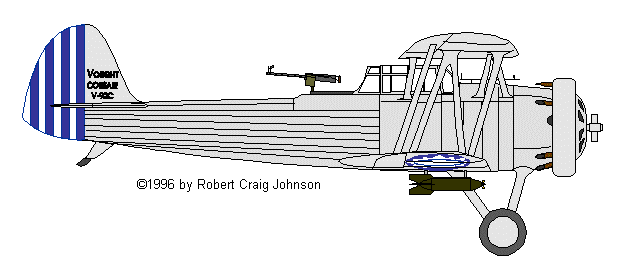 The Generalissimo had in any case been thoroughly assimilated to the Chinese rightists, militarists,
and warlords that controlled much of his army. He was all but completely dependent on
the advice of the army's chief of staff, the German mercenary Gen. von Falkenhausen (von Falkenhausen
successfully commanded China's forces until 1939, when Japanese pressure at last forced Hitler to
insist on his resignation). His army had the organization and outlook of a German Freikorps,
and its soldiers, with their Mauser K98 rifles and automatic pistols, their coal-scuttle helmets,
nd their potato-masher grenades, looked and fought like the thuggish Sturmtruppen of 1918-19.
The Generalissimo had in any case been thoroughly assimilated to the Chinese rightists, militarists,
and warlords that controlled much of his army. He was all but completely dependent on
the advice of the army's chief of staff, the German mercenary Gen. von Falkenhausen (von Falkenhausen
successfully commanded China's forces until 1939, when Japanese pressure at last forced Hitler to
insist on his resignation). His army had the organization and outlook of a German Freikorps,
and its soldiers, with their Mauser K98 rifles and automatic pistols, their coal-scuttle helmets,
nd their potato-masher grenades, looked and fought like the thuggish Sturmtruppen of 1918-19.
In 1927, Chiang acted on the reactionary sentiments of his circle and suddenly banned the Communist
Party. The decree automatically condemned everyone connected with the party to death. The gruesome
anti-communist reign of terror that Chiang set in motion would eventually cost at least 1,000,000
defenseless men, women, and children their lives. Grotesque, inhuman tortures, mass decapitations, and
systematic massacres of entire families and villages embittered the civil population and deprived Chiang's
army and police of the popular support they would need in the impending struggle with Japan. In spite of the
obvious dangers, Chiang remained ambivalent in the face of the latter's growing incursions into Chinese territory.
With the liquidation of the Communists now the sole, overriding objective of the Nationalist movement, the defense
of the national territory against foreign invasion seems to have been at best a secondary concern. Forces and
munitions were husbanded for use against the regime's battered former ally, even as the foreign
aggressor seized the regime's territory and killed its northern allies. At times, Chiang seems to
have looked on the fiercely anticommunist militarists of the Kwantung Army more as potential supporters
than as serious threats.
Despite their horrendous cost to his movement and people, Chiang's efforts were all for nought.
In 1933, the encircled, seemingly defeated Reds broke through Nationalist army lines and began their
epic Long March, a year-long, 6000-mile fighting retreat to the secure Communist base areas of north-
west China. The civil war that would end in 1948 with the Kuomintang’s ignominious retreat from
the mainland to Taiwan had now commenced.
Civil War, the Young Marshall, and the Bai Ying
The warlord's armed airliner and the general purpose biplane typified Chinese aviation during this
time of civil strife. The Red Army had no air force. It’s strength lay in its disciplined, peasant
infantry and its paramilitary, guerilla organization. Chiang Kai-shek and Gen. von Falkenhausen were thus chiefly
interested in light reconnaissance-bombers of the type that had proved so useful against the Reds
in Germany and the Baltic countries. 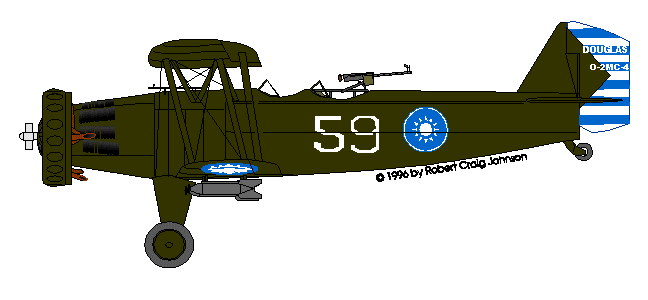 Between
1932 and 1936, the Nationalists bought 72 Douglas O-2MC-2 and -10 attack bombers and twenty Vought
V-92C Corsairs, as well as twenty-four Heinkel He 66Ch biplane dive bombers. These airplanes were good
counter-insurgency airplanes, well suited to close support of infantry, railroad route security, and
punitive raids on undefended villages. But the qualities that made them excellent for these purposes
left the two-seaters unable to defend themselves in the face of serious fighter opposition. The
warlord's bought similar airplanes, but also demonstrated a taste for armed airliners and executive transports.
Such aircraft could perform most of the duties of their military counterparts given the prevailing lack of opposition.
But they could also resupply isolated units of the leader's private army, boost his prestige, and transport
him in style and safety between different parts of his domain.
Between
1932 and 1936, the Nationalists bought 72 Douglas O-2MC-2 and -10 attack bombers and twenty Vought
V-92C Corsairs, as well as twenty-four Heinkel He 66Ch biplane dive bombers. These airplanes were good
counter-insurgency airplanes, well suited to close support of infantry, railroad route security, and
punitive raids on undefended villages. But the qualities that made them excellent for these purposes
left the two-seaters unable to defend themselves in the face of serious fighter opposition. The
warlord's bought similar airplanes, but also demonstrated a taste for armed airliners and executive transports.
Such aircraft could perform most of the duties of their military counterparts given the prevailing lack of opposition.
But they could also resupply isolated units of the leader's private army, boost his prestige, and transport
him in style and safety between different parts of his domain.
One such warlord's transport, a Boeing 247-D, called Bai-Ying or “White Eagle,” performed what was
perhaps the most important aerial service of the Sino-Japanese conflict: it brought about
a suspension of the civil war and allowed the Red and Nationalist armies to join forces against Japan.
The airplane belonged to one of the most successful Nationalist generals, the fiercely
anti-Communist, twenty-four year-old warlord Chang Hsueh-liang, called the “Young Marshall.” In 1935,
Chang bought the stock Boeing as his personal staff transport. It flew him in and out of the combat
areas and dropped supplies to his troops during the anti-Red purges and anti-warlord campaigns.
Chang and the Bai-Ying might never have distinguished themselves from dozens of others, had Chang's Tungpei Army
not itself fallen victim to the Imperial Japanese Army's insatiable appetite for expansion and Chiang Kai-shek's
obsessive campaign against communists and rivals, real or imagined. Chang’s power base lay in Manchuria.
When Japan seized this territory, Chang's men were suddenly homeless. They might at any moment turn on the
Young Marshal whose policies had failed them. At this critical juncture, Chiang decided to let the Japanese
dispose of the charismatic Chang, a potential rival and critic of Chiang's quiescence in the face of foreign aggression.
The Generalissimo Chang had faithfully served flatly refused to help him and tried to turn the other generals and
warlords against him. The Young Marshal saw that he had to act immediately or lose the confidence of his troops.
Chang led the Tungpei Army into a series of disastrous battles with the Japanese in Manchuria.
His men fought well by all accounts, but they lacked the resources of their enemeies. Late in 1935,
the Tungpei Army was driven out of Manchuria altogether. Seriously weakened by its losses, it was
then badly defeated in an encounter with the Reds.
To Chang's surprise, the Communists did not massacre their many prisoners in the usual Nationalist fashion
(the heads of Red POWs, hung from signposts and telegraph lines, feature prominently in civil war-era photos).
Instead, the Manchurian troops were given a short but intense, anti-Japanese indoctrination and sent back to
their units. Their accounts of the efficiency, organization, high morale, and nationalism of the Red army and
populace made a deep impression on Chang. He immediately flew in his Boeing 247 to the Red capital in Yenan and
signed an immediate secret truce. Then, when Chiang Kai-shek came to Sian to harangue the defeated troops, the
Young Marshal called an immediate meeting of the divisional commanders of both Nationalist armies in the area.
He convinced them that Chiang had to be arrested and forced to fight the invaders. That done, Chang’s bodyguard
invested Chiang Kai-shek’s quarters and arrested the Generalissimo. Within hours, army units across China declared for
the mutineers.
The Nationalist dictator expected to be killed. But instead, Chang sent his Boeing to fetch a
Communist delegation from Yenan and various military leaders from other parts of China. The
Reds asked for nothing from Chiang Kai-shek but a cessation of civil hostilities and an
immediate war on Japan under his leadership. They joined the Young Marshal in pressing for the
Generalissimo’s immediate release, though many nervous army officers preferred that he be immediately
tried and executed. Chiang Kai-shek was released, and he kept his promise. But he never forgave Chang
Hsueh-liang. When the honorable Young Marshal flew to Nanking in his Boeing and surrendered to
Chiang by way of apology for his conduct at Sian, the Generalissimo had him imprisoned. The KMT even
took him with them when they fled to Taiwan, where he remained in prison well into the 1990s.
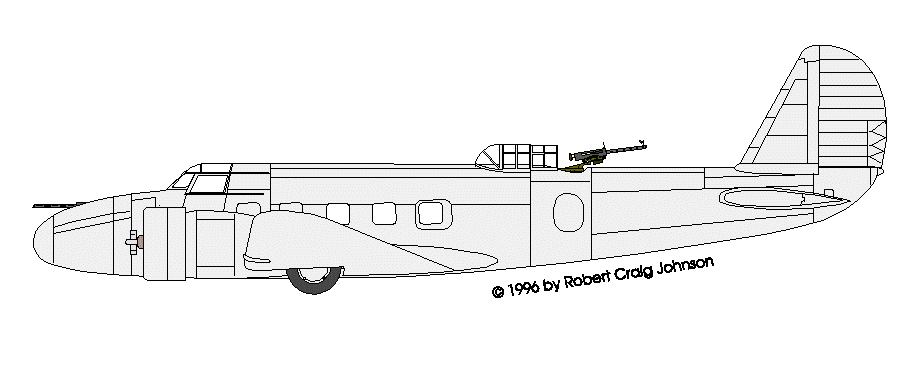
Before his arrest, the young Marshal had ordered a second Boeing, the subject of the illustration.
Long-range fuel tanks of the kind used in the MacRobertson trophy-race 247 replaced the uncomfortably
cramped forward passenger cabin. The growing threat of Japanese fighters led to the installation of
three .50-cal. machine guns, one replacing the lavatory and two fixed in the nose baggage compartment.
Chang was already in prison when the plane was delivered, and it never saw any useful service. A KMT
pilot flew it into a mountain shortly after delivery.
The Mercenaries: The 14th Squadron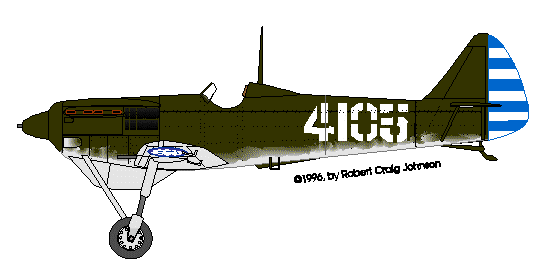
In its early phases, the air war against Japan was fought largely by the foreign mercenary pilots
of the 14th Squadron. This unit’s airmen included pilots from the United States and France with a few
Australians thrown in. Several had recently served on the Republican side in Spain. Its commander
was an American WW1 veteran, Vincent Schmidt, and its air gunners and ground staff were Chinese. The
squadron’s equipment was equally cosmopolitan: Vultee V-11 and Northrop 2E light bombers, a couple
of Martin 139 medium bombers, an armed Bellanca 28-90 racing plane, and a pair of Dewoitine D-510
fighters.
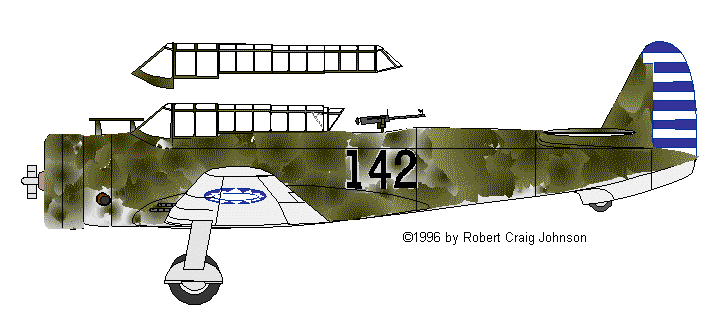
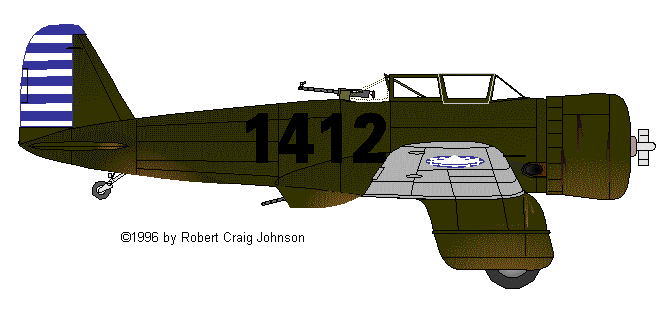
In July 1937, the Japanese invaded China proper, seizing Peking on the 28th. The 14th Squadron’s
Northrops carried out some of China’s first offensive action against Japan when they bombed Japanese
lines on 14 August, 1937. 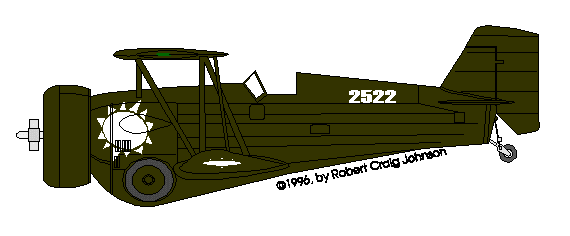 On the night
of May 19, 1938, Chinese crews flew two of the unit’s surviving Martin bombers on a leaflet raid over
Nagasaki. Western pilots also served on Hawk IIIs at Hanchow (4th Wing) and on D-510s at Kunming.
On the night
of May 19, 1938, Chinese crews flew two of the unit’s surviving Martin bombers on a leaflet raid over
Nagasaki. Western pilots also served on Hawk IIIs at Hanchow (4th Wing) and on D-510s at Kunming.
The Kuomintang and the Soviets
Soviet airmen and equipment poured into China after the Japanese attacks began. I-15bis fighter
biplanes and I-16 monoplanes were probably the most numerous warplanes in China prior to Pearl Harbor
and open American intervention. China’s long range bomber force was composed almost entirely of
Russian-flown Tupolev SB-2s, a number of which raided Japanese-occupied Formosa (now Taiwan).
Unfortunately, little seems to be now be known about this largely clandestine operation.
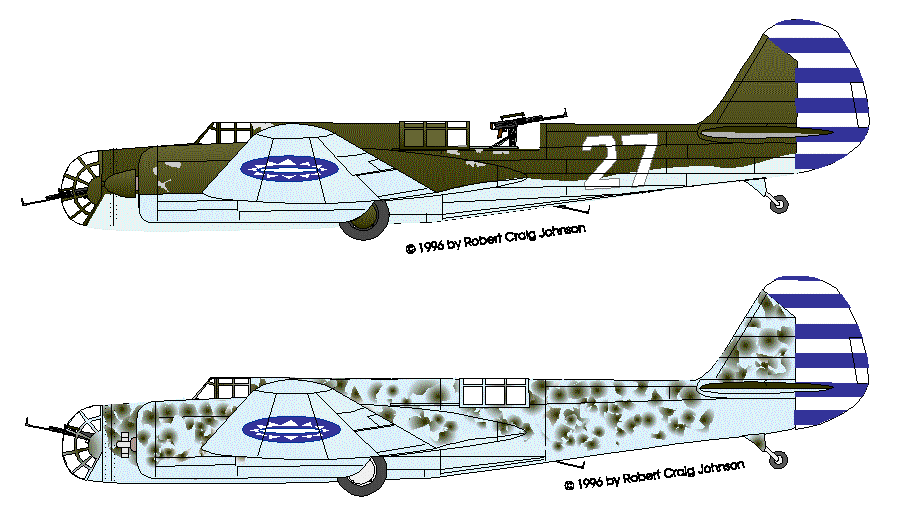
Aircraft Types Reliably Reported to Have Served in China
Camouflage and Markings
Chinese Nationalist airplanes were often delivered in silver dope or natural metal. But most
received a camouflage finish consisting of dark, olive green on all surfaces. Sometimes only the
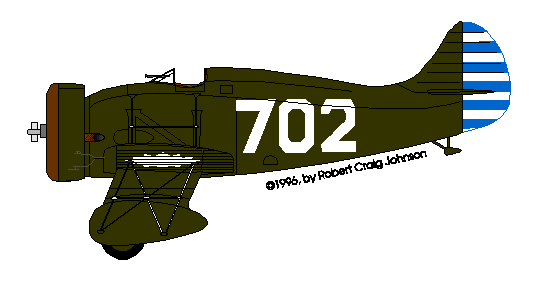 upper surfaces were painted,
the undersides of the flying surfaces and, often, the fuselage being left in unpainted metal
or aluminum dope. The camouflage paint seems to have worn rapidly, so many aircraft have a mottled
appearance. Soviet aircraft normally carried standard VVS camouflage: olive green upper surfaces and pale
blue-grey undersurfaces. But the top sides of SB-2s and I-153s were sometimes given a green mottle
over bare metal or, possibly, light blue-grey. Some Vultees may have also carried this type of
camouflage. The Boeing 281 Pea-shooters based at Nanking were at first painted pale grey overall.
Later, this gave way to the standard dark green on all surfaces, though fighters serving in the
same units can be seen in both finishes. Curtiss Hawks were always green on all surfaces.
upper surfaces were painted,
the undersides of the flying surfaces and, often, the fuselage being left in unpainted metal
or aluminum dope. The camouflage paint seems to have worn rapidly, so many aircraft have a mottled
appearance. Soviet aircraft normally carried standard VVS camouflage: olive green upper surfaces and pale
blue-grey undersurfaces. But the top sides of SB-2s and I-153s were sometimes given a green mottle
over bare metal or, possibly, light blue-grey. Some Vultees may have also carried this type of
camouflage. The Boeing 281 Pea-shooters based at Nanking were at first painted pale grey overall.
Later, this gave way to the standard dark green on all surfaces, though fighters serving in the
same units can be seen in both finishes. Curtiss Hawks were always green on all surfaces.
Chinese markings varied considerably in this period. The standard markings were horizontal
blue-and-white rudder stripes and a white Nationalist star carried on the wings. China never
had air superiority. So, since friendly-fire was unlikely from above, only the undersurfaces
were marked. But these were not hard-and-fast rules. 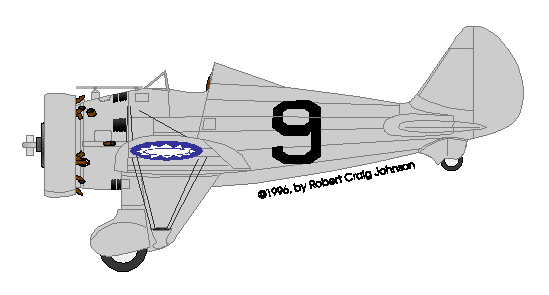 V-92 Corsairs were delivered with vertical rudder stripes, though this may
have been the result of confusion at Vought. On bare metal and some green-camouflaged aircraft,
the star was superimposed on a blue disk. When the undersurfaces were dark green, however, the
disk was normally omitted. Blue or black tactical numbers were carried on the rear fuselage sides.
They could be almost any shape, style or size, with lots of variation, even within units. National
insignia were not normally painted on the fuselage. However, some of the repainted Nanking Boeing
281s had the star and disk on the fuselage sides and some Hawk IIIs had ragged, hand-painted stars
on the sides of the nose. Presentation messages in white Chinese characters were sometimes painted
in the same position on Hawks. Since Japan's navy made extensive use of license-built Heinkel 66s
(Aichi D1A1/2 navy bombers), Chinese He66Ch aircraft carried large, yellow identification panels
on their wings and fuselages.
V-92 Corsairs were delivered with vertical rudder stripes, though this may
have been the result of confusion at Vought. On bare metal and some green-camouflaged aircraft,
the star was superimposed on a blue disk. When the undersurfaces were dark green, however, the
disk was normally omitted. Blue or black tactical numbers were carried on the rear fuselage sides.
They could be almost any shape, style or size, with lots of variation, even within units. National
insignia were not normally painted on the fuselage. However, some of the repainted Nanking Boeing
281s had the star and disk on the fuselage sides and some Hawk IIIs had ragged, hand-painted stars
on the sides of the nose. Presentation messages in white Chinese characters were sometimes painted
in the same position on Hawks. Since Japan's navy made extensive use of license-built Heinkel 66s
(Aichi D1A1/2 navy bombers), Chinese He66Ch aircraft carried large, yellow identification panels
on their wings and fuselages.
Kit Availability
At one time or another, kits of many of the aircraft described here have been available from a
number of manufacturers. Among the bombers and transports, the Martin 139/B-10 and the Boeing 247D
are available in 1/72 scale from Williams Brothers. The same firm’s 1/72-scale Northrop Gamma could
also be converted to represent a model 2E attack bomber with relatively little difficulty. The
Curtiss Shrike has been offered in both 1/72- and 1/48-scale vacuform kits over the years. The
Tupolev SB2 was released as a rather clumsy 1/72-scale kit by Frog, since re-issued by Novo.
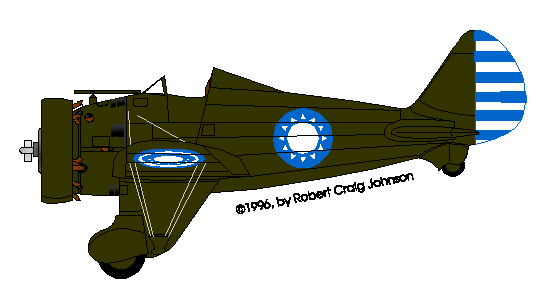 But MPM has a far better
1/48-scale vacuform, complete with the requisite Chinese insignia. The big Curtiss BT-32 Condor
biplane was once offered as a vacuform, maker and scale now forgotten. A 1/72-scale Hawk III has
just been released by the Czech MPM firm, complete with Chinese markings. Hasegawa’s 1/32-scale
U.S. Navy BF2C-1 Goshawk could, with different markings be a Chinese Hawk III. If you want a
1/48-scale Hawk, you could try to convert Lindberg’s elderly but nice BFC-2 Goshawk. The conversion
would not be trivial. Or you could get Sierra's multimedia/vacuum-formed model, which also comes with
Chinese decals. The Boeing 281/P-26 was released in 1/32 scale by Hasegawa and in 1/48 scale by Hobby Craft.
Both are excellent kits, though the Hobby Craft is more modern. Revell and Matchbox have released 1/72-scale
kits in the past.
But MPM has a far better
1/48-scale vacuform, complete with the requisite Chinese insignia. The big Curtiss BT-32 Condor
biplane was once offered as a vacuform, maker and scale now forgotten. A 1/72-scale Hawk III has
just been released by the Czech MPM firm, complete with Chinese markings. Hasegawa’s 1/32-scale
U.S. Navy BF2C-1 Goshawk could, with different markings be a Chinese Hawk III. If you want a
1/48-scale Hawk, you could try to convert Lindberg’s elderly but nice BFC-2 Goshawk. The conversion
would not be trivial. Or you could get Sierra's multimedia/vacuum-formed model, which also comes with
Chinese decals. The Boeing 281/P-26 was released in 1/32 scale by Hasegawa and in 1/48 scale by Hobby Craft.
Both are excellent kits, though the Hobby Craft is more modern. Revell and Matchbox have released 1/72-scale
kits in the past.
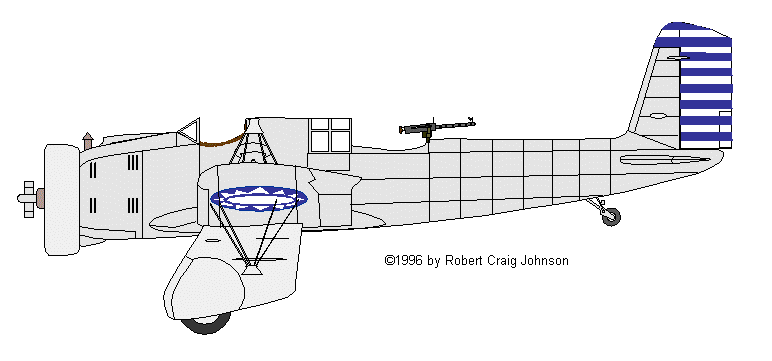
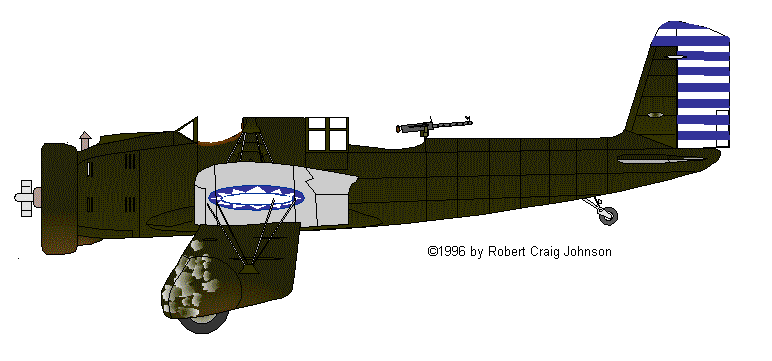
The Dewoitine D-510 is available as a basic but very fine
kit from Heller (and/or Smer). FIAT CR-32s have been released by Artiplast/SMER in 1/50 scale and by
Italeri/ Supermodel/SMER in 1/72 scale. Both kits are quite acceptable, though the 1/50 offering is
really old. I saw a 1/48 scale Fw 58 recently in vacuform (by Falcon or MPM). The Gladiator is
available in a number of 1/72-scale kits from Heller, Matchbox, and, most recently, Encore. The Encore
kit includes decals and painting instructions for a Chinese example. The admirable old 1/48-scale Impact kit
has also been re-released by Lindberg with excellent decals (no Chinese though). The I-153 can be had
in 1/72-scale from Heller, in 1/48-scale from Classic, or in 1/48-scale vacuform
from MPM. Aviation Usk has a 1/72-scale I-152 with Chinese markings. The I-16 can be obtained in
1/72-scale from Hasegawa (the old Revell kit is none too accurate) or from Hobby Craft’s excellent
1/48-scale kits (you will need to correct the exhausts, but that is not all that hard).
Sources
Bowers, Peter. Boeing P-26 Variants. Aerofax Minigraph 8 (Osceola, WI: Motor Books, nd).
van der Linden, F. Robert. The Boeing 247 (Seattle: U of Washington P—National Air and Space Museum, 1991).
Munson, Kenneth. Fighters Between the Wars and Bombers Between the Wars (New York: MacMillan, 1970).
Snow, Lois Wheeler. Edgar Snow’s China (New York: Random House, 1981).
Taylor, John W. R., ed. Combat Aircraft of the World (New York: Putnam’s, 1969)
Wagner, Ray. American Combat Planes. 3rd Ed. (Garden City, NY: Doubleday, 1982). .
Next page
Return to Table of Contents
© 1996 by Robert Craig Johnson. Part of a series first published, in abbreviated form, in Eagle Droppings, the Newsletter of the Rocky Mountain Chapter, IPMS/USA.
 The Generalissimo had in any case been thoroughly assimilated to the Chinese rightists, militarists,
and warlords that controlled much of his army. He was all but completely dependent on
the advice of the army's chief of staff, the German mercenary Gen. von Falkenhausen (von Falkenhausen
successfully commanded China's forces until 1939, when Japanese pressure at last forced Hitler to
insist on his resignation). His army had the organization and outlook of a German Freikorps,
and its soldiers, with their Mauser K98 rifles and automatic pistols, their coal-scuttle helmets,
nd their potato-masher grenades, looked and fought like the thuggish Sturmtruppen of 1918-19.
The Generalissimo had in any case been thoroughly assimilated to the Chinese rightists, militarists,
and warlords that controlled much of his army. He was all but completely dependent on
the advice of the army's chief of staff, the German mercenary Gen. von Falkenhausen (von Falkenhausen
successfully commanded China's forces until 1939, when Japanese pressure at last forced Hitler to
insist on his resignation). His army had the organization and outlook of a German Freikorps,
and its soldiers, with their Mauser K98 rifles and automatic pistols, their coal-scuttle helmets,
nd their potato-masher grenades, looked and fought like the thuggish Sturmtruppen of 1918-19.  Between
1932 and 1936, the Nationalists bought 72 Douglas O-2MC-2 and -10 attack bombers and twenty Vought
V-92C Corsairs, as well as twenty-four Heinkel He 66Ch biplane dive bombers. These airplanes were good
counter-insurgency airplanes, well suited to close support of infantry, railroad route security, and
punitive raids on undefended villages. But the qualities that made them excellent for these purposes
left the two-seaters unable to defend themselves in the face of serious fighter opposition. The
warlord's bought similar airplanes, but also demonstrated a taste for armed airliners and executive transports.
Such aircraft could perform most of the duties of their military counterparts given the prevailing lack of opposition.
But they could also resupply isolated units of the leader's private army, boost his prestige, and transport
him in style and safety between different parts of his domain.
Between
1932 and 1936, the Nationalists bought 72 Douglas O-2MC-2 and -10 attack bombers and twenty Vought
V-92C Corsairs, as well as twenty-four Heinkel He 66Ch biplane dive bombers. These airplanes were good
counter-insurgency airplanes, well suited to close support of infantry, railroad route security, and
punitive raids on undefended villages. But the qualities that made them excellent for these purposes
left the two-seaters unable to defend themselves in the face of serious fighter opposition. The
warlord's bought similar airplanes, but also demonstrated a taste for armed airliners and executive transports.
Such aircraft could perform most of the duties of their military counterparts given the prevailing lack of opposition.
But they could also resupply isolated units of the leader's private army, boost his prestige, and transport
him in style and safety between different parts of his domain.



 On the night
of May 19, 1938, Chinese crews flew two of the unit’s surviving Martin bombers on a leaflet raid over
Nagasaki. Western pilots also served on Hawk IIIs at Hanchow (4th Wing) and on D-510s at Kunming.
On the night
of May 19, 1938, Chinese crews flew two of the unit’s surviving Martin bombers on a leaflet raid over
Nagasaki. Western pilots also served on Hawk IIIs at Hanchow (4th Wing) and on D-510s at Kunming. 
 upper surfaces were painted,
the undersides of the flying surfaces and, often, the fuselage being left in unpainted metal
or aluminum dope. The camouflage paint seems to have worn rapidly, so many aircraft have a mottled
appearance. Soviet aircraft normally carried standard VVS camouflage: olive green upper surfaces and pale
blue-grey undersurfaces. But the top sides of SB-2s and I-153s were sometimes given a green mottle
over bare metal or, possibly, light blue-grey. Some Vultees may have also carried this type of
camouflage. The Boeing 281 Pea-shooters based at Nanking were at first painted pale grey overall.
Later, this gave way to the standard dark green on all surfaces, though fighters serving in the
same units can be seen in both finishes. Curtiss Hawks were always green on all surfaces.
upper surfaces were painted,
the undersides of the flying surfaces and, often, the fuselage being left in unpainted metal
or aluminum dope. The camouflage paint seems to have worn rapidly, so many aircraft have a mottled
appearance. Soviet aircraft normally carried standard VVS camouflage: olive green upper surfaces and pale
blue-grey undersurfaces. But the top sides of SB-2s and I-153s were sometimes given a green mottle
over bare metal or, possibly, light blue-grey. Some Vultees may have also carried this type of
camouflage. The Boeing 281 Pea-shooters based at Nanking were at first painted pale grey overall.
Later, this gave way to the standard dark green on all surfaces, though fighters serving in the
same units can be seen in both finishes. Curtiss Hawks were always green on all surfaces.  V-92 Corsairs were delivered with vertical rudder stripes, though this may
have been the result of confusion at Vought. On bare metal and some green-camouflaged aircraft,
the star was superimposed on a blue disk. When the undersurfaces were dark green, however, the
disk was normally omitted. Blue or black tactical numbers were carried on the rear fuselage sides.
They could be almost any shape, style or size, with lots of variation, even within units. National
insignia were not normally painted on the fuselage. However, some of the repainted Nanking Boeing
281s had the star and disk on the fuselage sides and some Hawk IIIs had ragged, hand-painted stars
on the sides of the nose. Presentation messages in white Chinese characters were sometimes painted
in the same position on Hawks. Since Japan's navy made extensive use of license-built Heinkel 66s
(Aichi D1A1/2 navy bombers), Chinese He66Ch aircraft carried large, yellow identification panels
on their wings and fuselages.
V-92 Corsairs were delivered with vertical rudder stripes, though this may
have been the result of confusion at Vought. On bare metal and some green-camouflaged aircraft,
the star was superimposed on a blue disk. When the undersurfaces were dark green, however, the
disk was normally omitted. Blue or black tactical numbers were carried on the rear fuselage sides.
They could be almost any shape, style or size, with lots of variation, even within units. National
insignia were not normally painted on the fuselage. However, some of the repainted Nanking Boeing
281s had the star and disk on the fuselage sides and some Hawk IIIs had ragged, hand-painted stars
on the sides of the nose. Presentation messages in white Chinese characters were sometimes painted
in the same position on Hawks. Since Japan's navy made extensive use of license-built Heinkel 66s
(Aichi D1A1/2 navy bombers), Chinese He66Ch aircraft carried large, yellow identification panels
on their wings and fuselages.  But MPM has a far better
1/48-scale vacuform, complete with the requisite Chinese insignia. The big Curtiss BT-32 Condor
biplane was once offered as a vacuform, maker and scale now forgotten. A 1/72-scale Hawk III has
just been released by the Czech MPM firm, complete with Chinese markings. Hasegawa’s 1/32-scale
U.S. Navy BF2C-1 Goshawk could, with different markings be a Chinese Hawk III. If you want a
1/48-scale Hawk, you could try to convert Lindberg’s elderly but nice BFC-2 Goshawk. The conversion
would not be trivial. Or you could get Sierra's multimedia/vacuum-formed model, which also comes with
Chinese decals. The Boeing 281/P-26 was released in 1/32 scale by Hasegawa and in 1/48 scale by Hobby Craft.
Both are excellent kits, though the Hobby Craft is more modern. Revell and Matchbox have released 1/72-scale
kits in the past.
But MPM has a far better
1/48-scale vacuform, complete with the requisite Chinese insignia. The big Curtiss BT-32 Condor
biplane was once offered as a vacuform, maker and scale now forgotten. A 1/72-scale Hawk III has
just been released by the Czech MPM firm, complete with Chinese markings. Hasegawa’s 1/32-scale
U.S. Navy BF2C-1 Goshawk could, with different markings be a Chinese Hawk III. If you want a
1/48-scale Hawk, you could try to convert Lindberg’s elderly but nice BFC-2 Goshawk. The conversion
would not be trivial. Or you could get Sierra's multimedia/vacuum-formed model, which also comes with
Chinese decals. The Boeing 281/P-26 was released in 1/32 scale by Hasegawa and in 1/48 scale by Hobby Craft.
Both are excellent kits, though the Hobby Craft is more modern. Revell and Matchbox have released 1/72-scale
kits in the past. 
